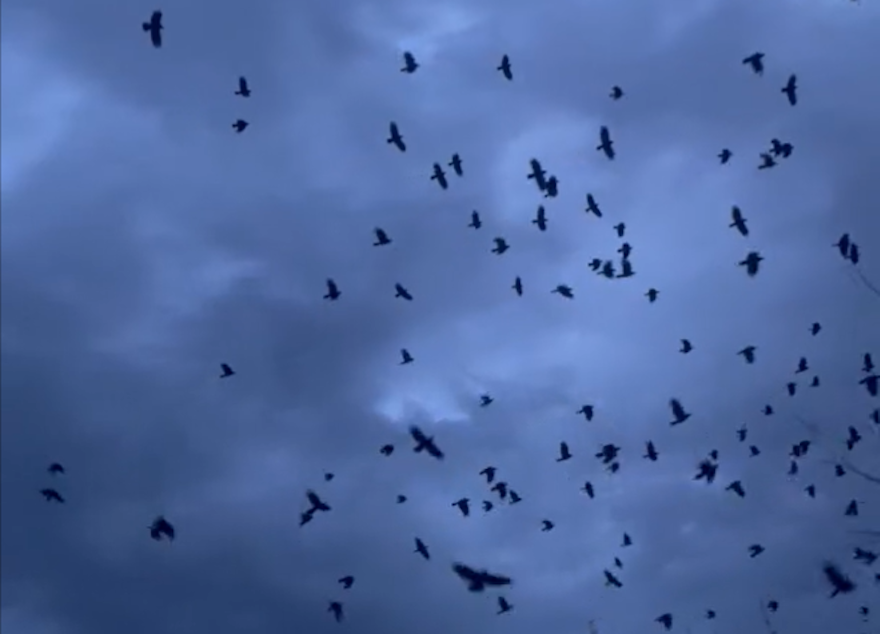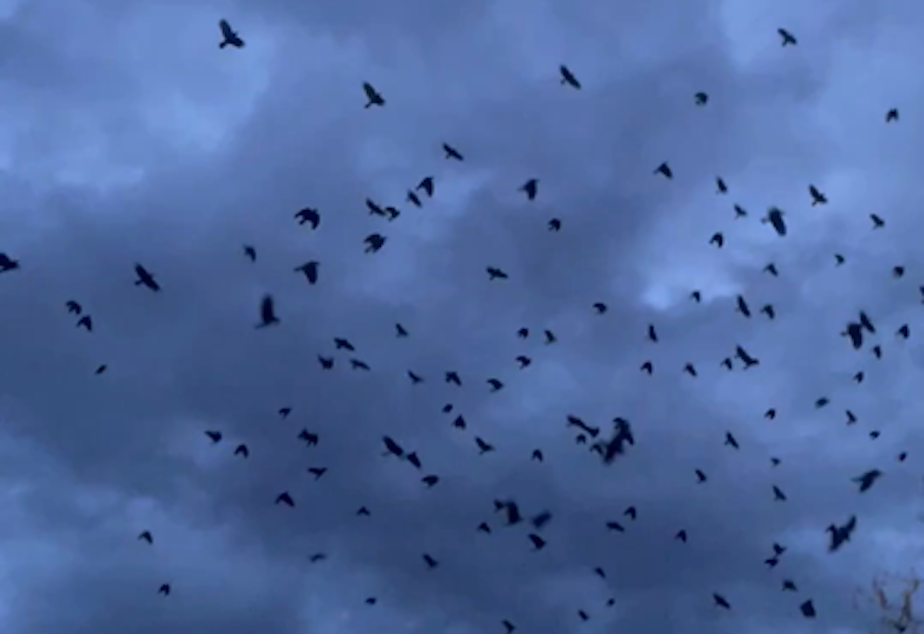Only murders in the roost: What springtime means for Seattle-area crow 'slumber party'

There's a spot on the University of Washington Bothell campus that is known for murders.
Not the kind that elicit blood-curdling screams. The kind punctuated by caws and the flapping of thousands of wings, which may be equally terrifying — depending on your opinion of crows.
You may have noticed our winged neighbors building and lining their nests in preparation for their breeding season. Expectant crow parents nest, and sleep, in their individual territories in early spring. Before that, many can be found roosting together by the thousands in spots like the UW Bothell campus near State Route 522.
RELATED: Where do Seattle-area crows go at night?
"These birds are territorial," said Loma Pendergraft, who teaches courses in animal behavior and communication at UW. "But despite the fact that they can be so aggressive to each other during the day, they will fly sometimes up to a dozen miles every night to come to one spot to sleep with thousands of other crows. And then in the morning, first light, they'll all depart."
As winter turns to spring and breeding season arrives, mates stay put in their individual territories to nest rather than roosting with the crowd.
Pendergraft, who studied crows' problem-solving skills, took a trip to UW Bothell with KUOW's Kim Malcolm.
Sponsored

 21 secs
KUOW's Kim Malcolm films as thousands of crows return to their roost on the University of Washington Bothell campus.
21 secs
KUOW's Kim Malcolm films as thousands of crows return to their roost on the University of Washington Bothell campus.
Sponsored
As many as 16,000 crows may travel to that spot each night, making for a heck of a crow slumber party. Pendergraft said it's like a festival, where they're trading information, socializing, and establishing a hierarchy in the branches. The more dominant crows claim spots toward the tops of the trees, where they're less likely to get an unpleasant surprise from crows above them.
"You'll notice that some of these birds in the morning look a little whitewashed," Pendergraft said. "They'll clean themselves up. But you know, no bird really wants to have to do that."
And, of course, these slumber parties prevent real murders — by predators.
Say there's a crow that roosts with four crow friends. A nearby owl takes one of you each night. That leaves you with a 20% chance of being snatched by the owl. Those odds change dramatically when the crow is just one of 15,000. In a larger roost, each crow has the protection of thousands who can raise the alarm before it's too late for their comrades.
Sponsored
In short, as many of us know from personal experience, crows are smart buggers that are constantly sharing information. It helps that they are unihemispheric sleepers. "That means that they sleep half their brain at a time, so they quite literally sleep with one eye open," Pendergraft said.
RELATED: Why crows are dive bombing unsuspecting Seattleites
In March, The Atlantic published an article that, if crows could read, may have stirred some controversy. The headline proclaimed, "Crows Are the New Pigeons," a thesis statement that wasn't exactly borne out in the article.
The article doesn't revisit the comparison to pigeons directly, but it does suggest their similarity in the sheer number of them in urban areas, because of access to food and space to roost. The Atlantic went to Portland for their perspective, which had a fair amount of concern for the mess crows leave, another possible similarity to pigeons, even if it wasn't explicitly stated. (Perhaps The Atlantic just wanted a reason to share the "Poopmaster 6000" with their audience.)
Sponsored
A similarity The Atlantic could have noted is how both crows and pigeons are more intelligent than humans may realize. Just last year, a study found that pigeons use a natural visual "algorithm" similar to artificial intelligence. That helps them excel at associative learning, much like a machine.
That's no match for the crow's intelligence, though.

Pendergraft recalled one particular crow that he'd caught for a study. Two weeks after that crow cohort was released, Pendergraft got a call from a Woodland Park Zoo keeper. The crow had been part of a pair that the keeper made friends with a year before it was caught. The keeper noticed when it disappeared — and thought it had been killed, not knowing it was in Pendergraft's care — and was shocked when it turned up again months later.
"I was really delighted to hear that, because not only was I able to re-test a crow for my study in the wild, but it was also evidence that these crows were able to reintegrate back into their old lives after spending a few months locked up in captivity in the winter," Pendergraft said.
Sponsored
As a scientist dealing with highly intelligent wildlife, he said that makes a big difference for him.
"I always worried that I was causing a permanent disruption on their lives," he said. "Maybe their mate found a new mate, and I ruined these birds lives. But that is evidence that they're able to get back to their old mate, get back in their old territory, and resume their old lives."






